 Hartlepool Sports & Leisure
Hartlepool Sports & Leisure
- Cinemas, Theatres & Dance Halls
- Musicians & Bands
- At the Seaside
- Parks & Gardens
- Caravans & Camping
- Sport
 Hartlepool Transport
Hartlepool Transport
- Airfields & Aircraft
- Railways
- Buses & Commercial Vehicles
- Cars & Motorbikes
- The Ferry
- Horse drawn vehicles
 A Potted History Of Hartlepool
A Potted History Of Hartlepool
- Unidentified images
- Sources of information
- Archaeology & Ancient History
- Local Government
- Printed Notices & Papers
- Aerial Photographs
- Events, Visitors & VIPs
 Hartlepool Trade & Industry
Hartlepool Trade & Industry
- Trade Fairs
- Local businesses
- Iron & Steel
- Shops & Shopping
- Fishing industry
- Farming & Rural Landscape
- Pubs, Clubs & Hotels
 Hartlepool Health & Education
Hartlepool Health & Education
- Schools & Colleges
- Hospitals & Workhouses
- Public Health & Utilities
- Ambulance Service
- Police Services
- Fire Services
 Hartlepool People
Hartlepool People
 Hartlepool Places
Hartlepool Places
 Hartlepool at War
Hartlepool at War
 Hartlepool Ships & Shipping
Hartlepool Ships & Shipping

Jackson Dock
Details about Jackson Dock
Jackson Dock opened 1st June 1852 and covered an area of fourteen acres. At the upper (west) side was a graving dock, for ship repairs.
Location
Related items :
 Building in scaffolding near Jackson Dock
Building in scaffolding near Jackson Dock
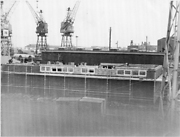 Donated by Hartlepool Museum Service
Donated by Hartlepool Museum ServiceBuilding in scaffolding near Jackson Dock.
More detail » Dam for New Lock Gates
Dam for New Lock Gates
 Created by Robert W. Williams
Donated by Hartlepool Museum Service
Created by Robert W. Williams
Donated by Hartlepool Museum ServicePart of the Robert W. Williams collection
Dated 1990
Jackson Dock 1990
More detail » Dock Scene
Dock Scene
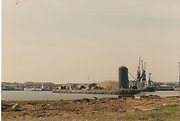 Created by Francis Elsdon
Donated by Hartlepool Museum Service
Created by Francis Elsdon
Donated by Hartlepool Museum ServicePart of the Elsdon Collection collection
Dated 1988
Dock Scene. View of Union Dock and Jackson Dock. Wingfield Castle on left of picture.
More detail » Galavale and Warehouse No.2
Galavale and Warehouse No.2
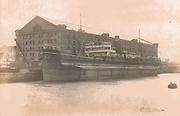 Created by L. Brittain
Donated by Les Hawksfield
Created by L. Brittain
Donated by Les HawksfieldThe Doxford-built 'turret' ship Galavale in Jackson Dock alongside No.2 Warehouse - possibly with a cargo of grain. In the left background is No.4 Warehouse (the Match Factory), which caught fire and was destroyed in August 1954.
More detail » Jackson Dock
Jackson Dock
 Donated by F.Wilson
Donated by F.WilsonTaken probably in the late 1950s/ early 1960s of Jackson Dock.
The Old West Quay and Premier Inn would now be facing the camera and in the distance on the left across union Dock is Middleton Road. Coal trucks can be seen in the centre.
More detail » Laid-up Colliers
Laid-up Colliers
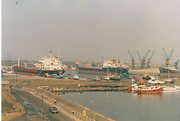 Created by Francis Elsdon
Donated by Hartlepool Museum Service
Created by Francis Elsdon
Donated by Hartlepool Museum ServicePart of the Elsdon Collection collection
Dated 1986
Laid-up Colliers in Jackson Dock, Hartlepool.
Landguard Point, Castle Point, Fort Point & Beacon Point.
More detail » Lock Gates 2
Lock Gates 2
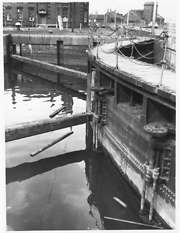 Donated by Douglas Ferriday
Donated by Douglas FerridayPart of the Hartlepool Library Service collection
Lock Gates next to the Dockmaster's Offices at Jackson Dock. Have now been replaced.
More detail » MV Cora (2)
MV Cora (2)
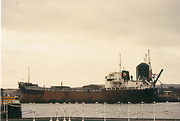 Created by Francis Elsdon
Donated by Hartlepool Museum Service
Created by Francis Elsdon
Donated by Hartlepool Museum ServicePart of the Elsdon Collection collection
Dated 1988
MV Cora, formerly 'Dolphin Point', in Jackson Dock, Hartlepool.
More detail » MV Dolphin Point & MV Beacon Point
MV Dolphin Point & MV Beacon Point
Part of the Elsdon Collection collection
Dated 1986
MV Dolphin Point & MV Beacon Point in Jackson Dock, Hartlepool.
More detail » MV Dolphin Point & MV Beacon Point (2)
MV Dolphin Point & MV Beacon Point (2)
Part of the Elsdon Collection collection
Dated 1986
MV Dolphin Point & MV Beacon Point. Laid up Colliers in Jackson Dock, Hartlepool.
More detail » MV Egton
MV Egton
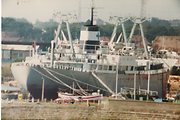 Created by Francis Elsdon
Donated by Hartlepool Museum Service
Created by Francis Elsdon
Donated by Hartlepool Museum ServicePart of the Elsdon Collection collection
Dated 1977
MV Egton. Arrived in Jackson Dock 24th Aporil 1977 and remained until she went to the breakers yard in Finland in 1986.
More detail » MV Gallic Fjord
MV Gallic Fjord
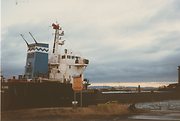 Created by Francis Elsdon
Donated by Hartlepool Museum Service
Created by Francis Elsdon
Donated by Hartlepool Museum ServicePart of the Elsdon Collection collection
Dated 1988
MV Gallic Fjord in the Jackson Dock, Hartlepool.
More detail » MV Landguard Point
MV Landguard Point
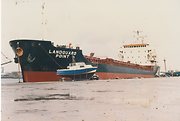 Created by Francis Elsdon
Donated by Hartlepool Museum Service
Created by Francis Elsdon
Donated by Hartlepool Museum ServicePart of the Elsdon Collection collection
MV Landguard Point in Jackson Dock, Hartlepool.
More detail » MV Landguard Point (2)
MV Landguard Point (2)
 Created by Francis Elsdon
Donated by Hartlepool Museum Service
Created by Francis Elsdon
Donated by Hartlepool Museum ServicePart of the Elsdon Collection collection
Dated 1986
MV Landguard Point in Jackson Dock.
More detail » MV Teviot
MV Teviot
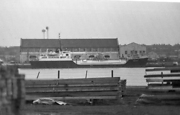 Donated by Hartlepool Museum Service
Donated by Hartlepool Museum ServicePart of the Storrow collection
Dated 1975
MV Teviot in Jackson Dock, Hartlepool.
More detail » MV Traquair
MV Traquair
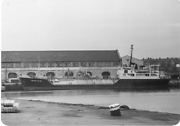 Donated by Hartlepool Museum Service
Donated by Hartlepool Museum ServicePart of the Storrow collection
Dated 1976
MV Traquair in Jackson Dock, Hartlepool.
More detail » MV Vera 1
MV Vera 1
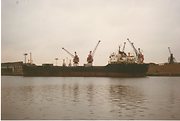 Created by Francis Elsdon
Donated by Hartlepool Museum Service
Created by Francis Elsdon
Donated by Hartlepool Museum ServicePart of the Elsdon Collection collection
Dated 1988
MV Vera 1 in the Jackson Dock, Hartlepool. Used to be called Fort Point.
More detail » MV Vindova
MV Vindova
 Created by Francis Elsdon
Donated by Hartlepool Museum Service
Created by Francis Elsdon
Donated by Hartlepool Museum ServicePart of the Elsdon Collection collection
Dated 1980
MV Vindova in Jackson Dock, Hartlepool. An ex trawler being scrapped.
More detail » Mars at Jackson Dock
Mars at Jackson Dock
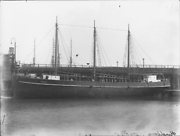 Donated by Hartlepool Museum Service
Donated by Hartlepool Museum ServiceDated 1915
Three masted sailing ship Mars at Jackson Dock in 1915. Written on the back of the photo is: Kindberg 5.10.15. This is likely to have been one of the ships repaired by Kindberg.
HHT&N 806
More detail » Running Trials (1)
Running Trials (1)
 Created by unknown
Donated by Hartlepool Library Service
Created by unknown
Donated by Hartlepool Library ServiceOne of Pounder's small boats running trials in Jackson's Dock sometime in the 1920s.
HHT&N794
More detail » SS Denebola
SS Denebola
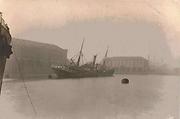 Created by unknown
Donated by Mr. Les Hawksfield
Created by unknown
Donated by Mr. Les HawksfieldDated 1909
The steamship Denebola moored in Jackson Dock awaiting unloading. She limped into port on October 29th, 1909, after her cargo of timber shifted during a stormy North Sea crossing.
More detail » St Jernvik unloading timber
St Jernvik unloading timber
 Donated by Hartlepool Museum Service
Donated by Hartlepool Museum ServiceSt Jernvik in Jackson Dock. The Dock Master's Office is in the centre distance. The ship was built in 1883 as Balbus, renamed Louise in 1892 & St Jernvik in 1918 by her Swedish owners. She was lost in a collision in 1928.
HHT+N 751
More detail » The remarkable affair at West Hartlepool Docks
The remarkable affair at West Hartlepool Docks
A ship got stuck going through the lock gates
On Tuesday 9th May, 1876, at ten minutes to four in the morning, a Norwegian ship called the Europa, tried to pass through West Hartlepool dock gates. She was heading towards Jackson Dock, but got stuck when half-way through.
The accident happened at high tide, when the deep water made it easiest for ships to come in and go out of the dock. When the Europa got stuck, the lock gates could not be closed to shut in the water, as they usually did. The tide would soon go out, and the water would run out of the dock.
The Europa was a Norwegian ship, from Sandjefjord, laden with timber. A powerful paddle steam tug, Conqueror, tried to haul Europa free. This did not work. Three more tugs joined the Conqueror, and they all tried in vain to tow her clear. As the tide was going out the ship had to stay where she was until the next high tide.
The worst that could have happened
If the worst had happened, there could have been two disasters. The first would be that all the ships in the dock would fall over sideways, because there wasn’t any water to hold them up. This would damage both themselves and any ship they fell onto. The second was that the sides of the dock could have caved in when the pressure of the water was not there to hold them out. This could have brought down the enormous warehouses built on the quayside.
Rumours brought a big crowd
Meanwhile, word had got around amongst the shipping community and the townspeople. The docks were rapidly emptying of water, it was said. The warehouses might come down, without the pressure of the water to hold up the dock walls.
Thousands of people flocked to the scene of the accident almost as soon as it had happened. Some of them may have realised what a disaster it could have been, but many probably came out of curiosity.
What did happen
Happily, the tide went down slowly enough, over about six hours, so that people working in the dock could prevent the ships’ damaging each other. They moved them further apart, to lessen the damage.
The sides of the dock did not fall in, so workmen at the dock took the opportunity to do some running repairs below the normal level of the water.
The dock officials did their best to avoid any accidents, but they could not prevent all of the damage. They shut the gates of the Swainson Dock, which protected the warehouses around that dock. The timber docks were also made safe.
But none of the other dock-gates could be closed. Those leading into the Coal Dock from Jackson Dock were hung so that the weight of water in the Coal Dock would have pushed them open. Hence all the vessels moored in these docks were left in a depth of about a metre of water. There were lots of ships in the dock and most of them fell over on their sides.
Although the dock officials put the ships further apart, there was some damage. About forty of the ships, which were made of wood, had their planks pulled apart as well as other damage. The ship Philo, was crushed by Her Majesty’s training ship Trincomalee, which lay next to her. The crew of the Trincomalee did their best to keep their ship in as upright a position as they could by means of mooring chains and ropes attached to mooring posts on the quayside.
Some of deck cargo was taken off Europa and she floated on the next tide. This was on Tuesday afternoon between three and four o’ clock. She was quite a heavy ship for the time, but being protected with copper underneath, escaped with relatively little damage.
The aftermath
The ship owners could have made claims against the Dock Company, for the damage to their ships. There were not as many claims made as the Dock Company feared. Those that did claim were mostly foreign owners, excepting Mr Isaac Bedlington of West Hartlepool, whose ship, the Deodar, was severely damaged. The Norwegian ship, the Familiar, was also very shaken up.
More detail » Tug Sandtex
Tug Sandtex
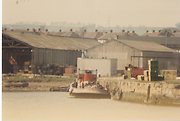 Created by Francis Elsdon
Donated by Hartlepool Museum Service
Created by Francis Elsdon
Donated by Hartlepool Museum ServicePart of the Elsdon Collection collection
Dated 1988
Tug Sandtex in the Jackson Dock, Hartlepool. It was later converted into a houseboat.
More detail » Unloading timber at Jackson Dock
Unloading timber at Jackson Dock
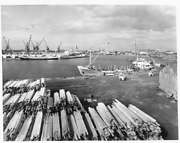 Donated by Douglas Ferriday
Donated by Douglas FerridayPart of the Hartlepool Library Services collection
Dated 1968
Jackson Dock in 1968. In the foreground the ship Roelof Jan is unloading her cargo of timber.
More detail » Wright
Wright
 Donated by Hartlepool Museum Service
Donated by Hartlepool Museum ServiceA well loaded Wright in Jackson Dock. This is possibly the previously named Harlseywood built by Ropner in Stockton in 1907 and renamed by her Stockholm owners in 1923. The image is from a glass plate negative
More detail »



